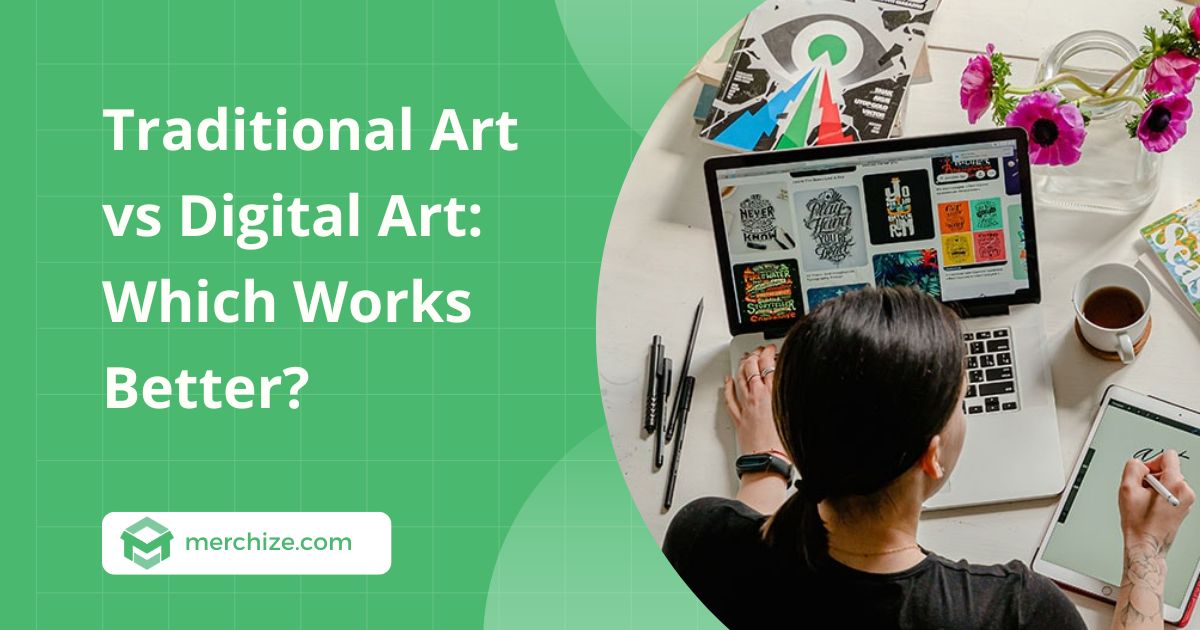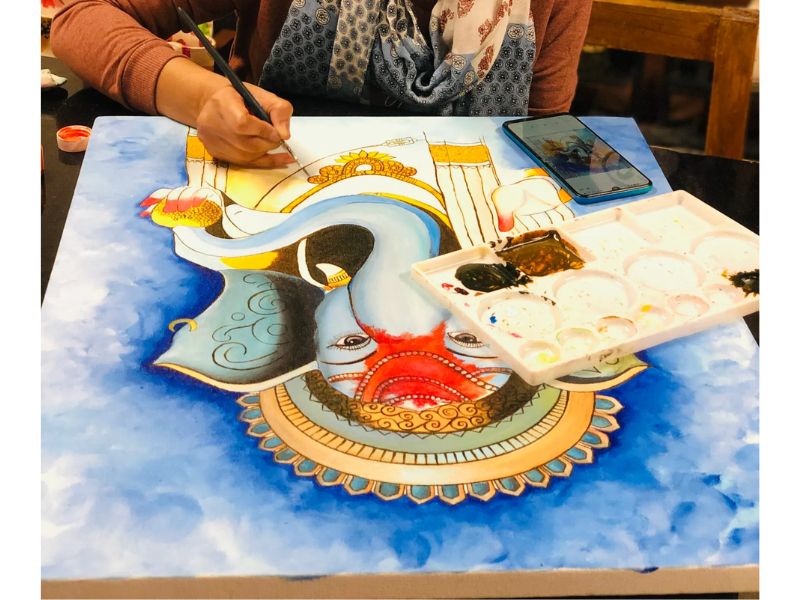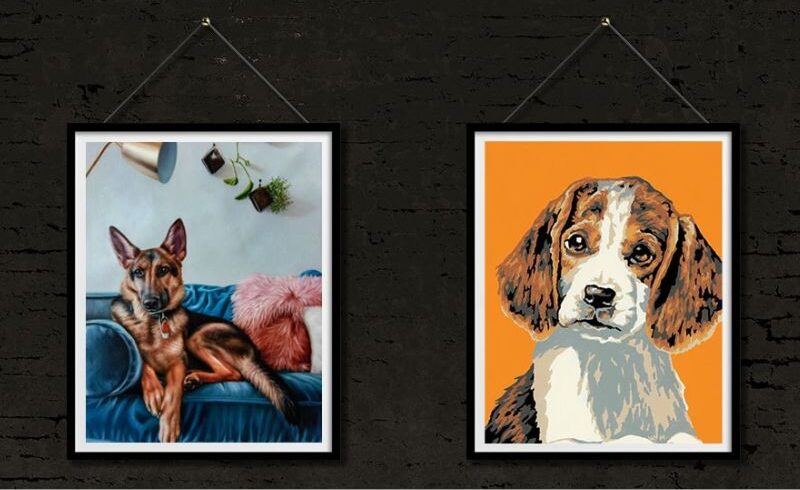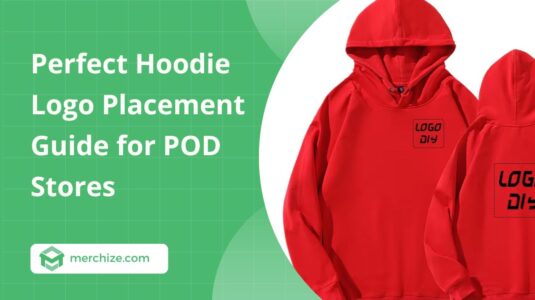Contents
In the world of print-on-demand, choosing the right artistic approach can make all the difference. Traditional art vs digital art each brings unique strengths; one offers the tactile charm of physical media, the other delivers speed, flexibility, and easy scalability. Understanding these differences helps POD sellers create stunning designs that captivate customers and maximize sales potential. Keep reading.
What is digital art?
Digital art is a form of art created using digital tools such as computers, tablets, or other electronic devices. It can take many forms, including digital illustrations, photographs, videos, or animations. Digital art has revolutionized the way artists create and share their work, offering a level of flexibility that traditional methods cannot easily match.
Pros
- Undo and edit easily: Mistakes can be corrected instantly, and changes to colors, shapes, or composition can be made without damaging the work.
- Versatile tools: Digital platforms offer brushes, textures, layers, and effects that would be costly or space-consuming in the physical world. You can simulate watercolor, oil painting, spray paint, or even animation all in one place.
- Easy sharing and distribution: Artwork can be shared instantly online, sold on e-commerce platforms, or sent for printing without scanning or photographing.
- Scalable and reproducible: Digital files can be scaled and reproduced without losing quality, making them ideal for print-on-demand (POD) products.
Cons
- Learning curve: Mastering software and hardware takes time, especially for beginners not familiar with technology.
- Screen fatigue: Long hours staring at a screen can cause eye strain and physical discomfort.
- Dependence on technology: Software glitches, hardware failures, or power outages can interrupt the creative process.
- Less tangible: Digital art lacks a physical presence unless printed, which may reduce the “hands-on” experience some artists value.
What is traditional art?
In contrast to digital art, traditional art is created using physical mediums such as pencils, charcoal, oil paints, clay, or canvas. This form of art has been practiced for centuries and continues to be widely appreciated even in the digital age.
Pros
- Tactile experience: The physical interaction with materials—like the glide of a pencil on paper or the texture of brushstrokes on canvas—offers a unique, tangible experience.
- Authenticity and originality: Each piece has a physical presence, making it ideal for galleries, exhibitions, or collectors who value owning an original artwork.
- Depth and texture: Natural imperfections, layers, and textures give traditional art a sense of depth and realism that is difficult to replicate digitally.
Cons
- Costly materials: High-quality paints, brushes, canvases, and other supplies can be expensive over time.
- Space requirements: Finished works and ongoing projects need physical storage, which can be challenging in small studios or home setups.
- Limited flexibility: Mistakes are harder to correct—there is no “undo” button, and errors may require significant effort to fix.
- Time-consuming: Each piece may take hours or days to complete, making large-scale production or multiple variations more difficult.
The similarity between digital and traditional art
Both digital and traditional art serve as mediums for creative expression, relying on skills, composition, lighting, color, and artistic vision. While the techniques differ, the ultimate goal is the same: to convey emotion and produce aesthetically valuable artwork. Many artists even combine the two approaches to create designs suitable for print-on-demand products.
The difference between digital and traditional art
Comparison table
| Criteria | Digital Art | Traditional Art |
| Editing Flexibility | Easy to edit, use undo, layers, quick color changes | Mistakes are hard to fix, require manual techniques |
| Texture | Smooth, sharp, precise control over details | Real textures from paper, paint, or pencil, unique feel |
| File Quality | High-quality export, easy to scale & duplicate | Requires scanning/photography, detail & color can be lost |
| Cost | Initial investment in equipment, saves on materials long-term | Materials consumed continuously, higher long-term cost |
| Storage | Stored digitally or in cloud, no physical space needed | Requires physical storage, hard to preserve long-term |
| Workflow Speed | Fast, easy to try layouts & create multiple versions, POD-friendly | Slow, each piece is unique, hard to replicate consistently |
1. Editing flexibility
Digital art offers unmatched flexibility when it comes to editing. Artists can easily undo mistakes, work with multiple layers, and adjust colors or details without affecting the overall composition. This makes it simple to experiment with different ideas and quickly refine designs.
For traditional art, correcting errors is much more difficult. Fixing mistakes often requires manual techniques such as erasing, repainting, or over-drawing, which can be time-consuming and sometimes impossible without compromising the piece. This limitation can slow down production, especially for POD sellers who need multiple variations of a design.
2. Texture
Digital art provides clean, smooth lines and precise control over every detail. Artists can simulate textures and effects, ensuring consistent results across multiple products. This predictability is helpful for maintaining a cohesive look in a POD catalog.
Traditional art, on the other hand, naturally carries textures from paper, paint, or pencil. These tactile qualities create a unique, one-of-a-kind feel that digital tools struggle to replicate. Each piece of traditional art has its own personality, which can make it more appealing for certain audiences.
3. File quality
Digital art can be exported in high resolution and easily scaled or duplicated without losing quality. This is particularly useful for POD sellers who need designs that work on various products, from mugs to posters to apparel.
Traditional art must be scanned or photographed to create digital files, which can result in a loss of detail or color accuracy. Reproducing multiple consistent copies of the same design can be challenging, making it less convenient for mass production.
4. Cost
Creating digital art requires an initial investment in equipment such as tablets, styluses, and software. However, once these tools are in place, artists save money on recurring materials like paper, paint, or pencils, which makes it more cost-effective in the long run.
Traditional art consumes materials continuously, and costs can add up quickly. Each new design may require fresh supplies, making long-term production more expensive. This can be a significant consideration for POD sellers who need to produce multiple designs efficiently.
5. Storage
Digital art can be stored on a computer or in the cloud, requiring no physical space. Files are easy to organize, backup, and access, which allows artists and POD sellers to maintain a large collection of designs without clutter.
Traditional art requires physical storage, which can take up a lot of space and be more difficult to manage. Artworks are also susceptible to damage, fading, or misplacement, making long-term preservation a challenge.
6. Workflow Speed
Digital art allows for fast creation and easy experimentation. Artists can quickly try different layouts, colors, or variations and generate multiple versions without starting over. This efficiency is ideal for POD sellers who need to test and launch designs quickly.
Traditional art has a slower workflow, as each piece is unique and replicating the same design consistently is difficult. Producing multiple versions of a design takes much more time, which can limit productivity and the ability to scale a POD business.
Which is better for POD?
Both traditional and digital art have their own strengths, and one cannot be considered “better” than the other. Art is art, and a well-executed digital illustration can evoke the same emotions as any traditional painting. Both forms require skill and talent, but digital art offers distinct advantages that optimize the workflow, especially for POD products.
One of the biggest advantages of digital art is the ability to easily adjust details in an illustration. Changing colors and moving unbalanced elements is extremely helpful, particularly when testing a design for the first time or exploring multiple color options.
Digital art also enables a faster workflow and consistent quality, which is crucial for reliably delivering products to customers. Creating print-ready files is simpler, layouts can be adjusted quickly to test multiple concepts, and designs can be scaled into multiple versions to maximize sales.
For POD, digital art often has the edge because it allows for quick file optimization and sharp, high-quality prints across various products. This efficiency makes it the preferred choice for many POD sellers.
>> Read more: How to print digital art with POD
Digital art products at Merchize
If you are selling POD products, choosing the right production platform for digital art is just as important as. This is why many sellers prefer Merchize, especially for printing digital illustrations. Consistent color quality and the ability to handle large files make Merchize a reliable choice for artwork POD.
Merchize offers a wide range of POD products suitable for both digital art and scanned traditional artwork, including posters, canvas prints, metal prints, apparel, hoodies, mugs, and home décor. Digital art files can be uploaded directly and maintain accurate colors during printing.
Scanned traditional artwork can also be beautifully printed on canvas or posters thanks to Merchize’s color-accurate printing technology. Sellers can quickly create multiple versions, including different colorways or textures, without compromising quality.
Some of the top digital art products you can sell on Merchize include canvas prints, posters, mugs, hoodies, and T-shirts. These products are especially popular for POD sellers looking to maximize sales while maintaining print quality.
For a full list of digital art-friendly POD products and more details, check out Merchize’s Top Digital Products.








